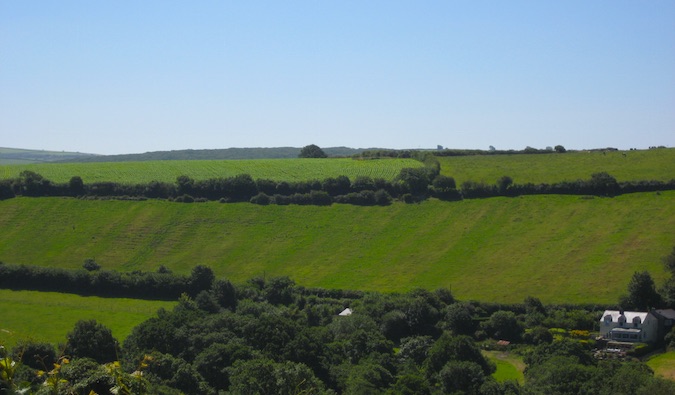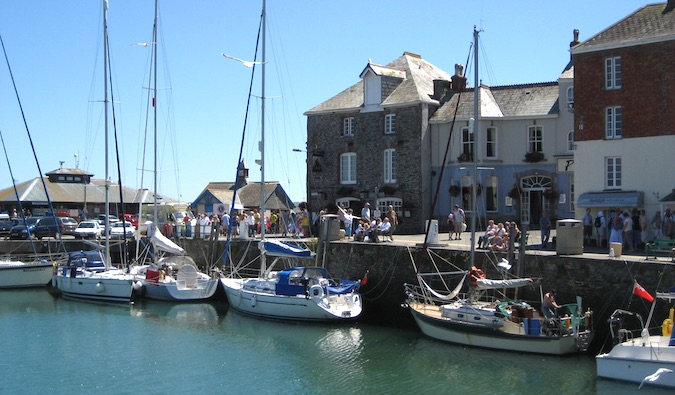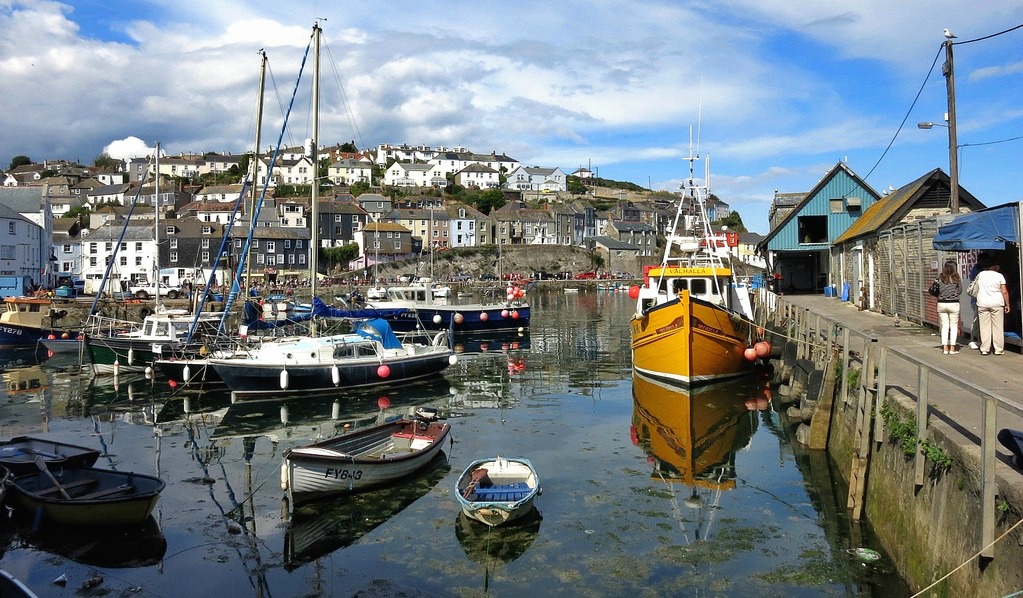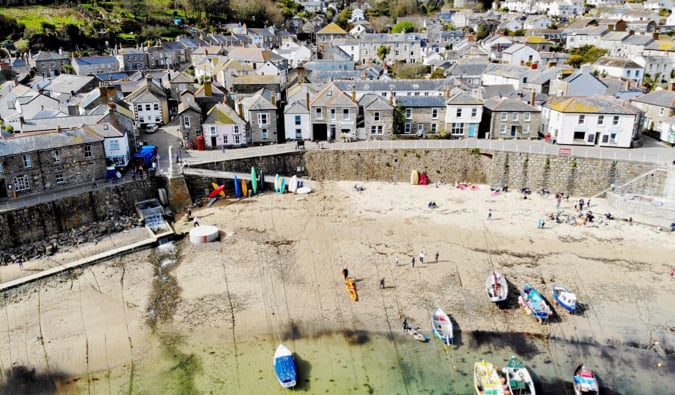Visiting the Beautiful Cornwall Region of England

The Cornwall region is the farthest west you can go in England.
The county is filled with farms, small towns (I stayed in Lostwithiel,
population 3,000), and tiny fishing villages. The area has been
populated since the Neolithic and Bronze Age. Eventually, the Britons
(who were Celtic in origin) claimed the region, with the first written
account of the region dating all the back to the 4th century BCE. It’s
been an important maritime region for centuries, though these days the
area isn’t held in high regard.
Cornwall is usually referred to as
the backwater of England and its residents as rubes. Its image in
England is like that of Kentucky or Tennessee in the United States. And, just like those two states, the stereotype of Cornwall is anything but true.
This
simple lifestyle is what gives Cornwall its charms and is one of the
reasons it’s been the best place I’ve been in England. I could have
easily spent the whole summer here relaxing, boating, biking, and
gardening.
Life around London
is busy. People in the street rarely acknowledge each other, it’s all
business, and everyone is rushing somewhere. You keep your head down and
go your own way. In Cornwall, everyone was friendly, life was slower,
the kids could stay out at night, and there are a plethora of outdoor
activities to keep you busy during the day. Though this difference could
be said about any rural/city comparison in the world, the analogy
certainly applies here and is why so many couples and families move here
from the Big Smoke.
I was out here visiting Cornwall to see my friends Mat and Kat. I’d met them while traveling Vietnam in 2006.
They had been cycling around Southeast Asia, and I was taking the
easier train/bus route. We met up occasionally and even biked the Mekong
Delta together (though that turned out to be a disaster). When I told
them I was coming to England, they were happy to have me and were
amazing hosts who tirelessly showed me all Cornwall had to offer.

Visiting
Cornwall, as it turns out, is very much like New England. On my first
night there, we went to this riverside restaurant for dinner. I had fish
and chips (the best I’ve had so far), and a few of their friends came
down and we spent the night chatting away. The restaurant was located on
the banks of a river dotted with little sailboats. Looking out over the
river, I felt like I was in the Hudson Valley in New York, with only the accents of the locals giving the location away.
That feeling stayed with me throughout my time in Cornwall.
The
following day we woke up early and headed to the Camel Trail. The Camel
Trail is a 12-mile bike trail from Bodmin to the small coastal town of
Padstow. The trail takes you along the Camel River through woods,
estuaries, and eventually up the coast. It was a beautiful, easy ride,
though by the end of the return trip I was a little tired since I’m
pretty out of shape. Biking along, we stopped at the Camel Valley
Vineyards, one of the few wineries in England to actually make something
drinkable. (Though I didn’t like their reds, their white wine was
tasty.)

From
the hill they’re on, you can see the surrounding farmland. Farms dot
the rolling hills, and cows and sheep can be seen for miles. The hilly
area reminded me of Vermont with its farms, wineries, and dairy
producers.
After a while, we ended in Padstow, and I felt like I’d
returned home. All around me people were sitting at the marina,
snacking on fried seafood and French fries as the seagulls circled
overhead waiting for their meal. Tourists flooded in and out of the
restaurants, and kids snacked on ice cream and fudge. Candy stores
selling rock candy and taffy lined the streets, and adults sat outside
with a beer. In the water, people sailed, wakeboarded, or swam while
some boats headed out to sea.
Yes, I had returned home to
Rockport, or Gloucester, or the fishing villages of Maine, where all the
locals go in the summer to escape the city.

We spent lunchtime there and, after digesting our meal, headed back home—but not before stopping off at the winery to pick up a few bottles of their white. That night, a BBQ erupted among the locals in the town center. Families kept showing up, and before you knew it, it seemed like half the town’s children were playing in the stream while the parents kept a watchful eye. It was a real, friendly, small-town atmosphere, and it’s part of the reason my friends fell in love with the place. Again, it was like being in New England. All around New England, small towns have a similarly close and cozy feel.

We spent lunchtime there and, after digesting our meal, headed back home—but not before stopping off at the winery to pick up a few bottles of their white. That night, a BBQ erupted among the locals in the town center. Families kept showing up, and before you knew it, it seemed like half the town’s children were playing in the stream while the parents kept a watchful eye. It was a real, friendly, small-town atmosphere, and it’s part of the reason my friends fell in love with the place. Again, it was like being in New England. All around New England, small towns have a similarly close and cozy feel.
I always had a soft spot for the outdoors, and though I’m a city guy, I could easily spend a few months enjoying the area, with all those bike trails, rivers, woods, and fishing villages.
And, especially, the impromptu barbecues.
More Things to See and Do in Cornwall

To help you make the most of your trip, here are some highlights from the area you’ll want to check out:
1. Chygurno Gardens
This beautiful, unique, three-acre garden overlooks Lamorna Cove. It is a maze of steep pathways and terraces that have been carved into the rocks. It’s a great place to bring your own picnic and go for a stroll. You can easily spend a couple hours walking around here and taking in the view.
This beautiful, unique, three-acre garden overlooks Lamorna Cove. It is a maze of steep pathways and terraces that have been carved into the rocks. It’s a great place to bring your own picnic and go for a stroll. You can easily spend a couple hours walking around here and taking in the view.
1 Lamorna Cove, +44 1736 732153. Opening days and
times vary so be sure to check in advance. Admission is 5 GBP for adults
but children enter free!
2. Minack Theatre
The Minack Theatre is Cornwall’s world famous open-air theatre. It is carved into a granite cliff and overlooks Porthcurno Bay and offers performances from May- September. The area was first used for performances in the 1930s, with the venue growing in size over the years. These days, over 100,000 people visit the theatre each year.
The Minack Theatre is Cornwall’s world famous open-air theatre. It is carved into a granite cliff and overlooks Porthcurno Bay and offers performances from May- September. The area was first used for performances in the 1930s, with the venue growing in size over the years. These days, over 100,000 people visit the theatre each year.
Porthcurno, +44 1736 810181, minack.com. Prices vary depending on the event. See the website for performance information.
3. Chysauster Ancient Village
This Iron Age settlement is 2,000 years old and is one of the best examples of a settlement in the country. Archaeological investigations have revealed that these people were mostly farmers and might have also had pigs and goats. It’s a great snapshot of the past and worth checking out if you’re a fan of history.
This Iron Age settlement is 2,000 years old and is one of the best examples of a settlement in the country. Archaeological investigations have revealed that these people were mostly farmers and might have also had pigs and goats. It’s a great snapshot of the past and worth checking out if you’re a fan of history.
New Mill, +44 0370 333 1181,
english-heritage.org.uk/visit/places/chysauster-ancient-village. Closed
from November 5, 2018 to March 31, 2019. Adult tickets are 4.80 GBP,
with discounts for students, seniors, and children.
4. Hike or bike the Camel Trail
This was my favorite thing to do here. It’s one of the most popular bikes routes in the country and runs from Padstow to Wenford Bridge. The 28km trail passes through wooded countryside, estuaries, across wineries, and through small towns. It’s extremely flat and easy to do and can be done in a day! It’s a great way to get a sense for the region while getting some exercise!
This was my favorite thing to do here. It’s one of the most popular bikes routes in the country and runs from Padstow to Wenford Bridge. The 28km trail passes through wooded countryside, estuaries, across wineries, and through small towns. It’s extremely flat and easy to do and can be done in a day! It’s a great way to get a sense for the region while getting some exercise!
5. Visit St. Mawes Castle
Built between 1539-1545, St Mawes Castle is among the best-preserved of Henry VIII’s coastal artillery fortresses and the most elaborately decorated of them all. The castle was designed to sink passing enemy ships (primarily from nearby Catholic France and Spain). It’s amazing, huge, and the displays are quite informative!
Built between 1539-1545, St Mawes Castle is among the best-preserved of Henry VIII’s coastal artillery fortresses and the most elaborately decorated of them all. The castle was designed to sink passing enemy ships (primarily from nearby Catholic France and Spain). It’s amazing, huge, and the displays are quite informative!
Castle Drive,
St. Mawes, +44 370 333 1181,
english-heritage.org.uk/visit/places/st-mawes-castle. Open daily from
10am-6pm but check the website before your visit to confirm. Admission
is 6 GBP for adults with discounts available for children and families.
6. Visit Tintagel Castle
Legend says this is the birthplace of King Arthur. Explore the grounds, the castle, and you can even visit nearby “Merlin’s Cave.” Set high on the rugged North Cornwall coast with dramatic views and fascinating ruins, even if Arthur was never born here, it’s one of the prettiest castles in the area and definitely worth a visit.
Legend says this is the birthplace of King Arthur. Explore the grounds, the castle, and you can even visit nearby “Merlin’s Cave.” Set high on the rugged North Cornwall coast with dramatic views and fascinating ruins, even if Arthur was never born here, it’s one of the prettiest castles in the area and definitely worth a visit.
Castle Road,
Tintagel, +44 8407 70328,
english-heritage.org.uk/visit/places/tintagel-castle. The castle is
closed until spring 2019. Admission is 9.50 GBP for adults, with
discounts available for children and families.
7. Walk to St Michael’s Mount
While you can take the ferry over, walking to the island during low tide is much more fun. Located on the island are a castle and chapel which likely date back to a monastery from the 8th century. While much smaller than the Mont Saint-Michel in France, it definitely evokes the same feeling.
While you can take the ferry over, walking to the island during low tide is much more fun. Located on the island are a castle and chapel which likely date back to a monastery from the 8th century. While much smaller than the Mont Saint-Michel in France, it definitely evokes the same feeling.
8. The Tate St Ives
This is one of 4 Tate galleries in the UK, home to an incredible modern art collection (if modern art is your thing). It’s located right by the ocean and offers some great views in addition to some impressive art. Check the website for the most up-to-date list of exhibitions and events.
This is one of 4 Tate galleries in the UK, home to an incredible modern art collection (if modern art is your thing). It’s located right by the ocean and offers some great views in addition to some impressive art. Check the website for the most up-to-date list of exhibitions and events.
Porthmeor Beach, +44 0173 679 6226,
tate.org.uk/visit/tate-st-ives. Open Tuesday-Sunday from 10am-4pm.
Admission is 10.50 GBP for adults, with free entry to anyone under 18.
You can also get 1 GBP off your ticket price if you get there by public
transportation.



No comments